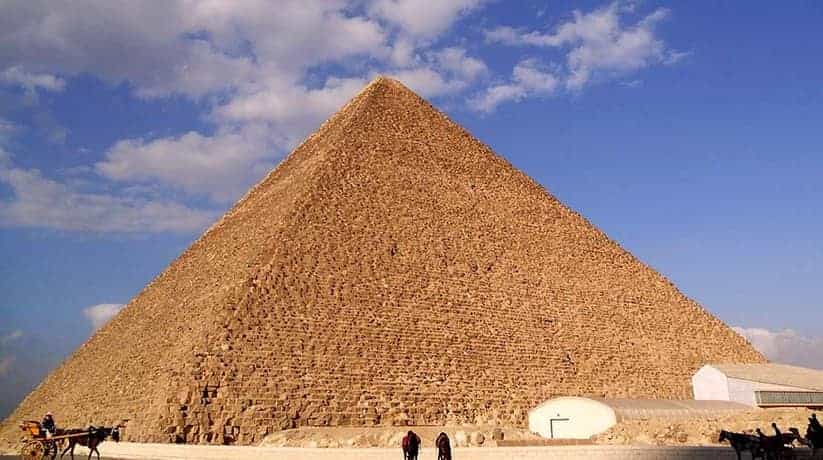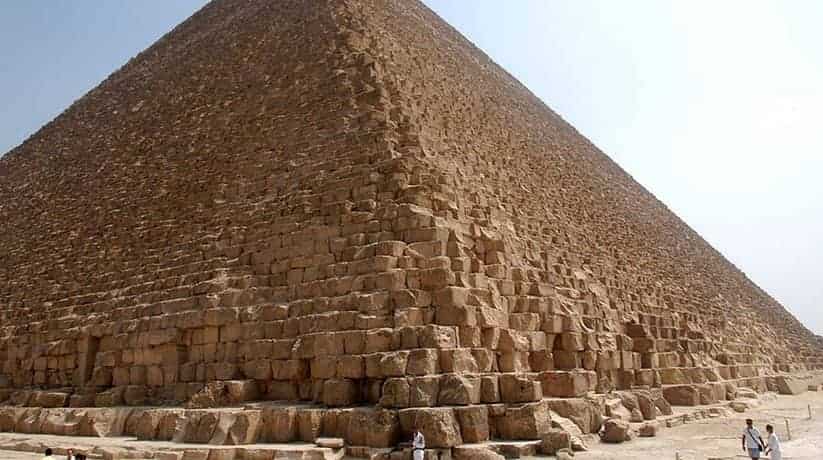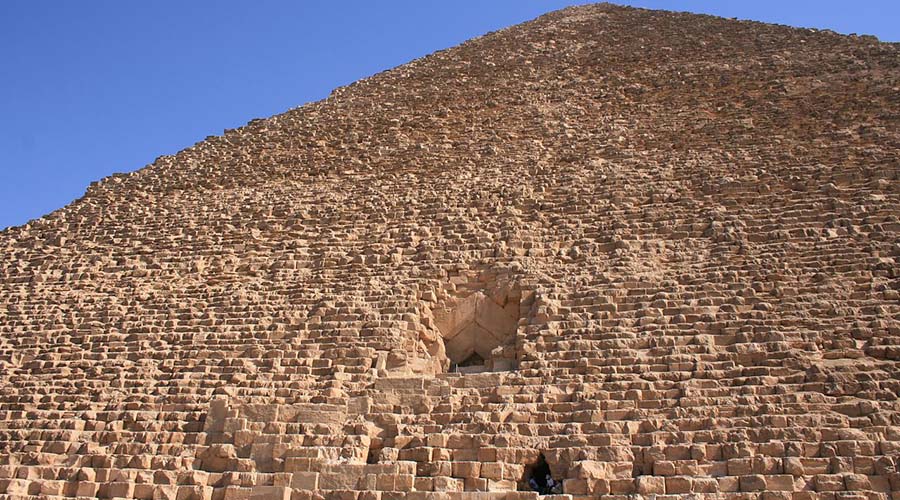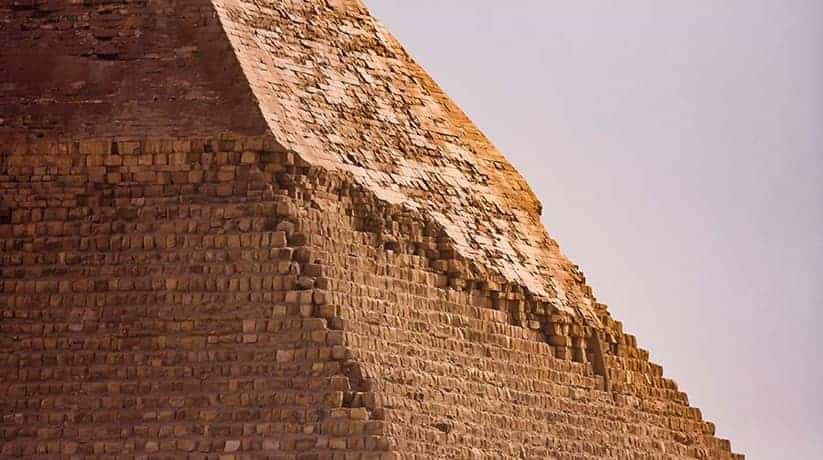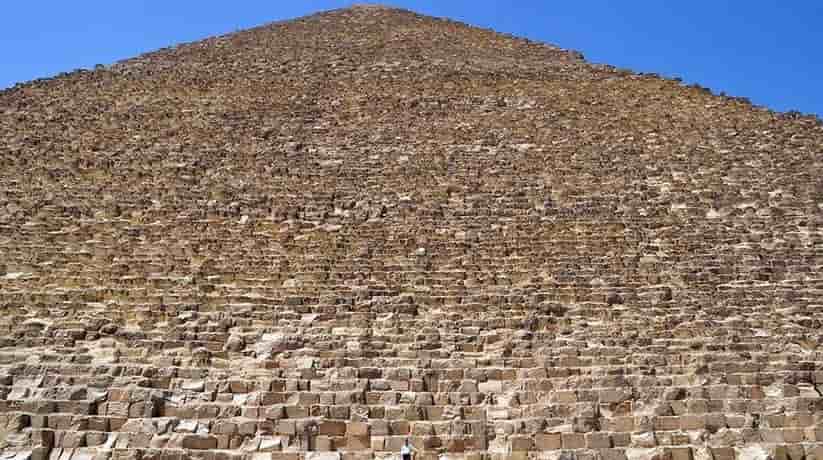Great Pyramid Giza Egypt tours, prices, booking, reviews
Great Pyramid Giza Egypt also called Khufu Pyramid. It also known as Cheops Pyramid. In fact, the Great Pyramid of Giza is the greatest pyramid among all pyramids in Egypt. How the Great Pyramid of Giza built, is a question that may never answered. Herodotus said that it took 30 years and 100,000 slaves to build Great Pyramid of Giza. Another theory says it built by peasants. They were unable to work the land while the Nile flooded between July and November. They maybe paid with food for their labor. The flooded waters also aided in the moving of the casing stones. In fact, these stones brought from Aswan and Tura. The water brought the stones right to Great Pyramid of Giza.
In fact, the Great Pyramid of Giza built between 2589 – 2566 BC. Moreover, it took over 2,300,000 blocks of stone with an average weight of 2.5 tons each. The total weight was 6,000,000 tons and a height of 482 feet (140 m). In fact, the Great Pyramid of Giza indeed is the largest and the oldest of the Pyramids of Giza. Not much known about Cheops (Khufu) who built the Great Pyramid of Giza. The tomb robbed long before archaeologists came upon it. Any information about him taken with the objects inside the tomb. Though he was ruler of a structured society and he must have been wealthy. Khufu buried alone in this massive tomb. Moreover, Cheops wives maybe buried nearby in smaller Mastabas.
Further details about the Great Pyramid Giza Egypt:
The encasing marble which covered the outside of the Great Pyramid of Giza eroded or removed over time. With this casing off, the Great pyramid of Giza lost 33 feet (11 m) of all its dimensions. Moreover, the top platform of the Great Pyramid of Giza is 10 m square. The base of the Great Pyramid of Giza is 754 feet and covers 13 acres. Furthermore, the original entrance to the Great Pyramid of Giza was about 15 m. In fact, it is higher than the entrance which used today. Al Mamum, who opened up the new passage, could not find the original opening. The new passageway leads straight across. Moreover, it joins in with the original passage, the descending passage. The descending passage led only to a subterranean chamber. This descending passage which leads down, set at a 26 degree angle.
Moreover, it descends down 345 feet (105 m) into the earth under the Great Pyramid of Giza. The passageway is only 3’6″ (1.1 m) wide and 3’11” (1.2 m) high. The chamber closed to the public. Moreover, the chamber itself is room that measures about 46′ x 27’1″ x 11’6″ (14 x 8.3 x 3.5 m). There is a passage that leads 100 feet to the western side. The purpose of the pit is uncertain. It is possible that it could be the burial chamber, but after a change of plan, it abandoned. The descending passage beyond where the new entrance meets it, closed off by a steel door. Furthermore, the ascending passage rises at the same angle as the descending, 26 degrees. The ascending passage leads up into the Great Pyramid of Giza. Moreover, the ascending passage is the same dimensions as the descending.
More details about the Great Pyramid Giza Egypt:
It can be quite a difficult trek for some people. The passage leads on for 129 feet (39 m). At the point where the ascending passage levels off, you can go two different ways. If you continue on horizontally, this passageway leads into the Queen’s Chamber. In fact, the Queen’s Chamber never used. The floor in this room never polished, it’s still rough. Egyptology guides believe that the chamber brought to this point. And then, the builders changed their minds and moved to the King’s Chamber. There is a possible explanation for the abandonment. It is that the sarcophagus built for Cheops was much large for the narrow passageways which built. Moreover, there are ventilating shafts that are another mystery. These shafts sealed at the extremities on both shafts. The shafts must made as Cheops pyramid went up.
It is since the builders most likely not continued to make the shafts. In fact, it was after the decision to abandon the chamber. It also thought that these are not actually ventilation shafts. Moreover, they are more of a religious significance. This could related to the Ancient Egyptian’s beliefs. They believed that the stars inhabited by gods and souls of the dead. The second is more spectacular. It is the way at the leveling off point of the ascending passage. In fact, it was to continue upwards to the Grand Gallery. The gallery is 157 feet (48 m) long and 28 feet (8.5 m) high. It is at the same 26 degree angle as the passages. The roof of the gallery corbel-ed. It said that not a piece of paper or a needle can inserted between the stones making up the roof.
Further details about the Great Pyramid Giza Egypt:
The gallery is only 62 inches (1.6 m) wide at the bottom. Moreover, it is only 41 inches (1 m) wide at the top of the incline. The Grand Gallery leads into the King’s Chamber. The walls of the chamber made of pink Aswan granite. Inside this chamber is the large sarcophagus which made of Aswan red granite, with no lid. The sarcophagus must placed inside the chamber as the Great Pyramid of Giza built. It is much too large to move in afterwards, as was the usual custom of that time. The King’s Chamber is 34’4″ x 17’2″ x 19’1″ high (5.2 m x 10.8 m x 5.8 m high). This chamber also has the possible ventilation shafts as the Queen’s Chamber. They are at the same angle as the shafts in the Queen’s Chamber. The thought about the religious significance applies to these shafts as well.
The main feature of the sky at night, was the Milky Way. The stars thought to have been the Nile in the sky. The southern shaft from the King’s Chamber points to where Orion’s Belt in the ancient sky. The southern shaft of the Queen’s Chamber points to Sirius. The northern shaft of the King’s Chamber points to the circumpolar stars. These stars never disappear in the sky. It thought that these shafts were to help the spirit of the dead Pharaoh find the important stars. Above this chamber is a series of five relieving chambers. In fact, they are essential to support the weight of the stones above. They are also to distribute the weight away from the burial chamber. The top chamber has a pointed roof made of limestone blocks. This is the most important of the relieving chambers.
Around Cheops Pyramid (Khufu Pyramid):
In these chambers, found the only inscriptions in the whole Great Pyramid Giza Egypt or Cheops Pyramid. As you come out of Khufu pyramid you can see the remains of the original enclosure wall. It is on the north and east side. It lies about 10 m from the base of Cheops pyramid. Little remains of Cheops’ Mortuary Temple. What left is basalt paving and lies near the east side of the wall. You may also see occasional traces of the causeway. It leads from the valley temple in the village, Nazlat al-Samman, at the foot of the plateau. This causeway collapsed during the last 150 years. Three small pyramids stand to the east of Cheops pyramid. These thought to have been for his sister, Merits. She was also his wife and possibly two other queens. To the west of the Cheops pyramid or Khufu Pyramid is the Royal Cemetery. It contains 15 Mastabas.
Great Pyramid Giza Egypt recently opened to the public after closed for over 100 years. Discovered at this site was the mummy of a 4,600 year old female. She had a completely unique plaster encasement. It has never seen or found anywhere else. At the base of the south face of the Cheops Pyramid, sits the Boat Pits and museum. The five boat pits discovered in 1982. One boat located at the site and can seen at the museum. The boat, which encased in the stones, has no nails. It held together with ropes and pegs, but not nails, and is intact. The purpose of these boats may have intended for travel to the after-life. They maybe also are or to go with the Sun-God on his journey.

